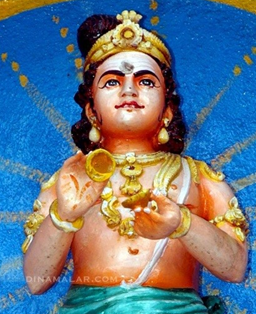Talk:The Nāyaṉmār Saints:Sambandhar(643–659CE)
By Vishal Agarwal
One of the greatest saints of Śiva-bhakti, Sambandhar was born in the 7th century in Sirkali, Tamil Nadu, to a pious brāhmaṇa, Śivapada Hṛdayar, and his virtuous wife, Bhagavathiar.
One day, Śivapada Hṛdayar and his wife took the child with them to the temple tank where they wished to bathe. The child looked at the tower of the temple and began to cry. Devi Pārvatī appeared and fed the milk of divine wisdom to Sambandhar. From the moment he drank the Milk of Wisdom (at the age of three), he began to sing soul-stirring songs in praise of Bhagavān Śiva.
The next day, Sambandhar went to a place called Thirukkolakkā. He sang a hymn in praise of the ‘Meaning of the Vedas’, clapping his hands to keep time. Pleased with this, Bhagavān Śiva presented him with a pair of golden cymbals (percussion plates). Sambandhar began singing with their accompaniment and continued on pilgrimages.
Wherever he went, crowds of people followed him, joining in the singing of bhajans. As he was just a little boy of eight years, enthusiastic bhaktas often carried him on their shoulders while he sang. Since his feet often became tired from walking from temple to temple, Bhagavān Śiva came in a dream to the priests of a mandir and asked that Sambandhar be taken around in a palanquin when singing bhajans to the crowds of bhaktas.
Once, he came to the home of a great Śiva-bhakta known as Śivanesha Chettiar in the town of Mylapore (close to modern-day Chennai). He learned that Śivanesha’s only daughter had died, but Śivanesha had loved her so much that he had preserved her bones after cremation in a pot in his home. Sambandhar asked for that pot and prayed to Śiva to bring the girl alive. A miracle happened as everyone watched in amazement, the daughter of Śivanesha arose from the bones and became a living human being.
After visiting many shrines and singing hymns in praise of the Lord, Sambandhar returned to Sirkali at the age of sixteen. There, many people urged him to get married because the Vedas commanded every human being to marry. Sambandhar agreed and was married to a beautiful girl. The marriage was conducted with great pomp. Soon after the marriage, Sambandhar and his bride went to a Śiva mandir in her hometown. As Sambandhar sang a bhajan to the Śiva-liṅga, a beam of light emerged from the mūrti and the couple merged into that light and disappeared. Bhagavān Śiva had taken Sambandhar and his wife to His own abode, granting them mokṣa.
Sambandhar is one of the most prominent of the sixty-three Nayanmār, Tamil Śaiva-bhakti saints. He composed three hundred and eighty-four songs in praise of Śiva in the Tamil language, contributing not only to the development of Śiva-bhakti but also to the development of music.



